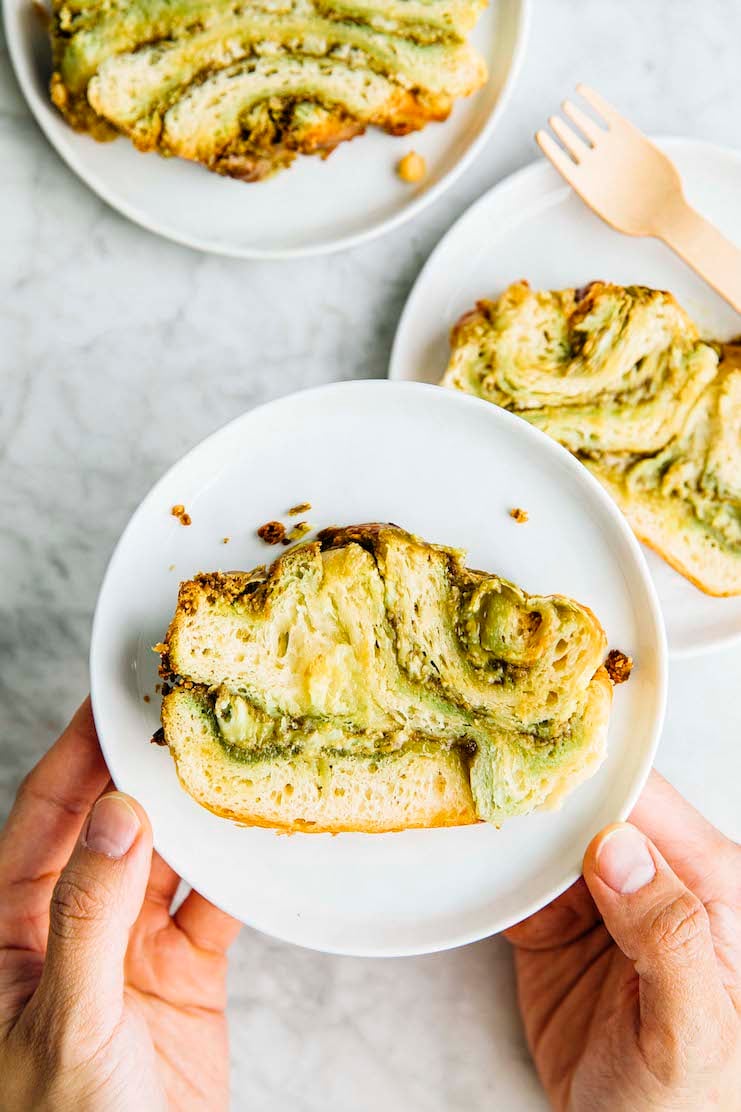
About This White Chocolate Pistachio Babka Recipe
This white chocolate pistachio babka recipe makes two delicious 9-inch babka loaves, both swirled with white chocolate chips and pistachio cream (a Nutella-like sweet nut spread, but made with pistachios instead of hazelnuts!). The dough is proofed overnight to ensure that you won’t spend all day in the kitchen waiting for the babkas to rise. I’ve also included tons of helpful tips, tricks, and step-by-step videos showing you how to braid the babkas!
What is babka?
But hold the phone—what even is babka, anyway?
Babka is a sweet braided baked good that’s a cross between a braided, enriched bread and cake. It is made with a yeast-leavened dough typically enriched with butter and/or oil, eggs, and milk. The dough is rolled out, spread with a filling (traditionally, fruit, chocolate, or cinnamon), then rolled up and braided for baking.
Is babka bread or cake?
It’s both! Because it’s made with yeast, it has the qualities of a sweet loaf bread. That means an airy, bread-like crumb with a subtle brioche-y, yeasted flavor. However, babka is also typically made with a low-gluten cake or pastry flour, and soaked like a cake.
Where is babka from?
According to Wikipedia, babka developed in the Jewish communities of Eastern European countries like Poland, Russia, and the Ukraine. However, it is incredibly popular in countries like Israel and the New York region of the United States.
In fact, babka became popular in the mid-2010s thanks to Breads Bakery, an Israeli-bakery (that I was lucky enough to tour when I went to Tel Aviv a few years ago!). In 2013, Breads Bakery opened their New York City location. Their babka quickly became a bestseller, with many local magazines naming it as one of the best babkas (if not the best!) in New York City.
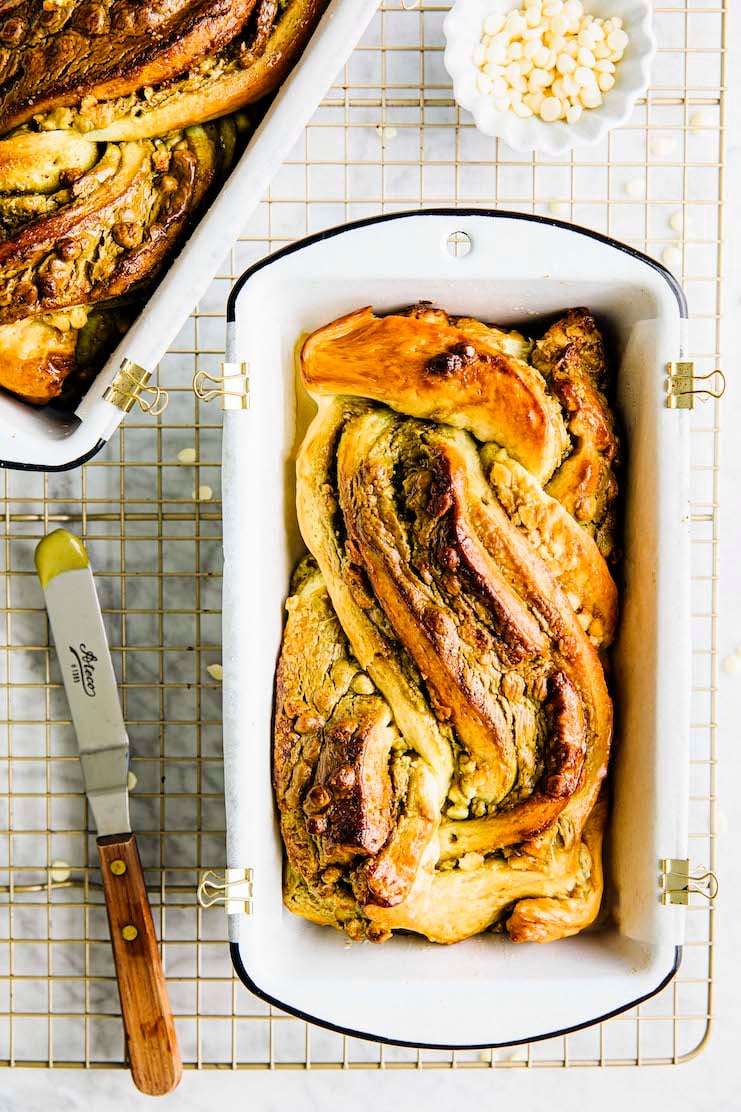
Why You Should Make This Recipe
Here are all the reasons to make this white chocolate pistachio babka recipe:
This white chocolate pistachio babka recipe uses a fun and unique ingredient from Costco: pistachio cream.
If you follow me on TikTok, you may already know that I recently discovered a huge jar of pistachio cream at Costco for a steal of a price. In fact, doing so is what inspired this white chocolate pistachio babka recipe! But what even is pistachio cream, anyway?
Think of it like Nutella, but made with pistachios instead of hazelnuts. And it’s not just any old nut butter like peanut butter either. Why? Nut butters are typically only made with one ingredient: nuts, ground up until they achieve the paste-like consistency of nut butter.
But pistachio cream is much sweeter, with a much more velvety and silky smooth texture. Because in addition to ground pistachios, pistachio cream also contains other ingredients like sugar, milk powder, and olive oil to give it its unique texture and flavor. It’s utterly addicting, especially when combined with the sweetness of white chocolate in this babka recipe.
@hummingbirdhigh found this amazing gem at @Costco!!! #baking #costcofinds #costcobuys #cooking #bakingrecipe ♬ Love You So – The King Khan & BBQ Show
This white chocolate pistachio babka recipe is flexible and can fit into any schedule easily.
One of the things I hate most about making elaborate bread recipes is how time-consuming the process can be. First, you have to make the dough and let it rise for 1 to 2 hours. After that, you then have to roll it out, assemble it accordingly, and then let that rise for another 1 to 2 hours. That’s before even baking the buns! By the time everything is baked and ready for serving, 4 to 5 hours have passed!
As a result, I like to divide the work for this babka recipe over a couple of days. I make the dough the night before I plan on serving the babka. I let the dough proof overnight in the refrigerator while I sleep. By the time I wake up, the dough has doubled in size. It is now perfect for shaping into the babkas!
This method also turns a baking recipe from a “Big Commitment” to a more manageable one that fits into your schedule. If this is your jam, I definitely encourage you to check out my cookbook, Weeknight Baking. I break down a lot of time-consuming baking projects—like making layer cakes or butter pie from scratch—in this way to make sure you’re not stuck in the kitchen for hours at a time. But of course, I like to give you options, too. I also include instructions on how to make the babka recipe all in one day!
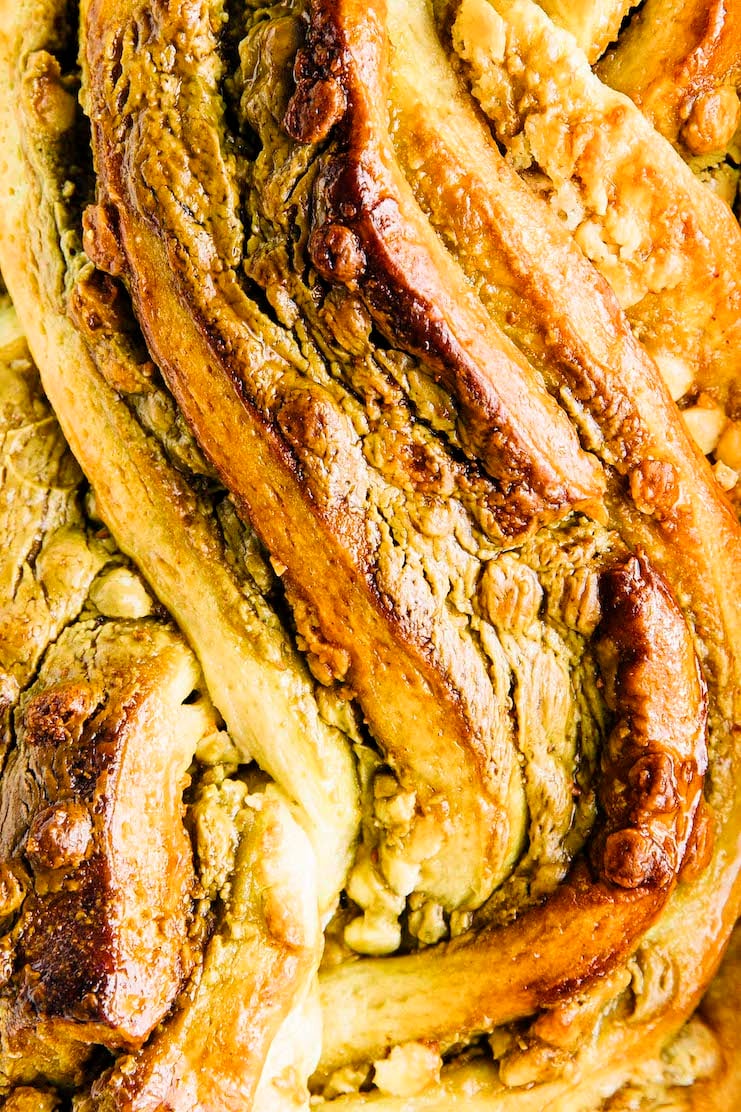
Ingredients and Substitutions
Now that I’ve convinced you to make white chocolate pistachio babka, here’s everything you need to make the recipe:
Shopping List for White Chocolate Pistachio Babka Recipe
Be sure to scroll down to the recipe card for the exact ingredient quantities—hit the “Jump to The Recipe” button on the page for a quick shortcut!
- all-purpose flour
- cake flour
- granulated sugar
- instant yeast
- kosher salt
- whole milk
- large eggs
- unsalted butter
- pure vanilla extract
- pistachio cream
- mini white chocolate chips
And let’s talk about some key ingredients and their potential substitutions:
Cake Flour
You need 2 cups plus 2 Tablespoons cake flour to make these white chocolate pistachio babkas.
Cake Flour versus All-Purpose Flour
In the grocery store, you’ll likely find an aisle of more flour varieties than you would have thought existed: all-purpose, bread, cake, pastry, and many more. These varieties are defined by their protein percentages. Cake flour contains less protein than all-purpose flour.
As a result, using cake flour in this recipe results in babkas with a softer and more tender crumb. If you need a brand recommendation, my favorite cake flour is Swans Down Cake Flour.
What else can I use instead of cake flour?
If you can’t find cake flour, you can use the same amount of pastry flour instead. Pastry flour also has less gluten than all-purpose flour and will produce similar results.
I don’t want to buy cake flour OR pastry flour for this recipe. Can I just use all all-purpose flour instead?
Technically yes, but I don’t recommend it. Your babkas will turn out denser than mine! They will be more like a swirly bread as opposed to a cross between a cake and a bread.
Instant Yeast
You need 2 and ¼ teaspoons instant yeast to make these white chocolate pistachio babkas.
What’s the difference between active dry yeast and instant yeast?
Good question! I highly encourage you to check out this article on The Kitchn explaining the difference between the two. In general, I prefer to use instant yeast in my recipes. Why? You get to skip a step, and it generally proofs faster than active dry yeast!
Can I use active dry yeast instead of instant yeast in this recipe?
Yes, but you will need to change the way you activate the yeast and mix it into the dough.
First of all, active dry yeast and instant yeast are activated at different temperatures. In general, recipes instruct you to activate active dry yeast with ingredients that are heated to between 110° and 115°F, and instant yeast with ingredients that are heated to between 120° and 130°F.
Second, in addition to these different activation temperatures, active dry yeast and instant yeast need to be activated in different ways. Bakers activate active dry yeast by soaking it in warm water with a little bit of sugar. Instant yeast, on the other hand, can be added directly to dry ingredients (like you would baking powder or baking soda) without needing to be soaked beforehand.
So, if you’re planning on using active dry yeast in this recipe, add it directly to the warm milk and let sit for 5 minutes or until foamy and emitting a distinct yeasty flavor. Then, pour it into the dry ingredients and follow the recipe’s directions for adding the eggs, butter, and vanilla extract.
Kosher Salt
You need ½ teaspoon kosher salt to make these white chocolate pistachio babkas.
Why You Should Use Kosher Salt When Baking
I like to use kosher salt (as opposed to table salt) when baking. Its larger crystals make it difficult to confuse with granulated sugar. However, not all kosher salts are created equal. Some kosher salts have smaller granules than others, which will result in saltier tasting baked goods.
For consistency, I recommend sticking to one brand, and one brand only: Diamond Crystal kosher salt. It’s the only brand of salt I use when I develop recipes for Hummingbird High. Why? Diamond Crystal kosher salt is one of the few 100% pure salts in the grocery store. Other brands have additives that can add unexpected flavors to your desserts.
I can’t find Diamond Crystal kosher salt. Is Morton’s Coarse kosher salt okay?
Yes, with reservations. Morton’s Coarse kosher salt granules are much smaller, denser, and crunchier than Diamond Crystal. According to this Food52 article, the two are different shapes and sizes because of how they’re made. Morton’s is made by flattening salt granules into large thin flakes by pressing them through high-pressure rollers, whereas Diamond Crystal is formed by a patented method in which “upside-down pyramids [are] stacked one over the next to form a crystal.” You can even see a visualization of the different sizes in this Cook’s Illustrated article.
Okay, but what does that mean, exactly? 1 teaspoon of Morton’s will taste saltier than 1 teaspoon of Diamond Crystal. Wild, right? So if you follow my recipes exactly as they are written but use Morton’s instead of Diamond Crystal, the results will come out saltier. In fact, sometimes they will come out TOO salty. So if you’re using Morton’s instead of Diamond Crystal, reduce the salt in the recipe by half.
Want to learn more about Diamond Crystal versus Morton’s Coarse kosher salt? Definitely check out the Food52 and Cook’s Illustrated articles I linked to above, as well as this Taste article.
I can’t find Diamond Crystal OR Morton’s Coarse kosher salt. Can I just use table salt?
Yes, with reservations. If you use table salt, you’ll need to reduce the recipe’s salt quantity by half.
If you read my little essay about Diamond Crystal and Morton’s, you learned that Diamond Crystal kosher salt granules are larger than Morton’s kosher salt granules. The same principle applies to table salt versus kosher salt. Table salt granules are much smaller than kosher salt granules. As a result, 1 teaspoon of table salt tastes much saltier than 1 teaspoon of kosher salt… simply because it can hold more granules! Wild, right?
So if you follow my recipes exactly as they are written but use table salt instead of kosher salt, the results will come out saltier. If you’re using table salt instead of kosher salt, I recommend reducing the salt in the recipe by half.
Whole Milk
You need ½ cup whole milk to make these white chocolate pistachio babkas.
Can I use skim, low-fat or non-fat milk instead?
Yes, but with reservations. Skim, low-fat, and non-fat milks will lead to less flavorful baked goods.
Can I use non-dairy milk like almond milk, coconut milk, soy milk, or oat milk instead?
Yes! You can use alternatives like almond milk, coconut milk, soy milk, and/or oat milk in this recipe without altering the results. However, be mindful that using an alternative milk with “strong” flavors (like coconut or oat milk) will impart their flavors into the babkas, too. Specifically, your babkas might have a subtle coconut or oat milk flavor to them, too.
Pistachio Cream
You need 1 cup pistachio cream to make these white chocolate pistachio babkas.
What is pistachio cream?
Pistachio cream is similar to Nutella, but without the chocolate and made with pistachios instead of hazelnuts! However, don’t confuse it with nut butter. While nut butter tends to be made exclusively from nuts, pistachio cream contains other ingredients like sugar, milk powder, and olive oil to give it an extra smooth and velvety texture.
Seriously—it’s so good, I can eat the stuff by the spoonful!
Where can you buy pistachio cream?
I found a huge jar of Pisti Pistachio Cream at my local Costco—it’s what inspired this recipe! But you can also find smaller (but more expensive, ugh) jars online on Amazon.
From their selection, I can recommend the following brands: Il Colle Del Gusto Pistacchiosa, Pisti Cream of Pistachio (it’s what I used!), and Vincente Sicilian Cream of Pistachio Nut Spread.
I don’t want to buy pistachio cream. Can I make my own pistachio butter instead?
Technically yes, but I’m not sure I recommend it. I mentioned before that pistachio cream is different from pistachio nut butter. Pistachio cream contains other ingredients like milk powder, sugar, and oil to give it its extra creamy, sweet, and luscious texture.
Pistachio butter, especially the homemade kind, will be a lot more chunky and have the texture of a natural chunky peanut butter. It also won’t be as sweet. While you can still make this white chocolate pistachio babka recipe with it, your babka will probably be less sweet than mine. It will also be harder to put together since the chunky nut butter will probably tear the delicate babka dough.
But if you insist, you can look up a recipe for homemade pistachio butter and give it a try!
I don’t love pistachios. What can I use instead of pistachio cream?
Wait, what? Why are you on this recipe for white chocolate pistachio babka then?!
All joking aside, no worries! You can easily replace the pistachio cream with the same amount of another kind of spread like Nutella (like I did in this recipe for Nutella babka!), nut butter, or even a cookie butter like Speculoos (I believe Claire Saffitz has a recipe for this in her cookbook, as seen in this YouTube video). In the past, I’ve also made an ube babka with ube halaya jam and a pumpkin chocolate babka with pumpkin puree. The world is your oyster!
Mini White Chocolate Chips
You need 1 cup mini white chocolate chips to make these white chocolate pistachio babka.
Mini white chocolate chips, really? Can I use regular sized white chocolate chips instead?
Technically yes, but I still recommend mini white chocolate chips over regular sized ones. Why? Their smaller size makes the babka easier to assemble. The mini chips disperse more easily when you sprinkle them over the babka. They also tend to stay in place better when you roll the dough. Plus, because they disperse more easily, it ensures you get chocolate with almost every bite. Have I convinced you yet?
What kind of mini white chocolate chips did you use?
I used the mini white chocolate chips from Whole Foods Market.
Can I use white chocolate from chocolate bars instead?
Absolutely! To do so, just chop up 6 ounces (170 grams) of white chocolate into ¼- and ½- inch pieces.
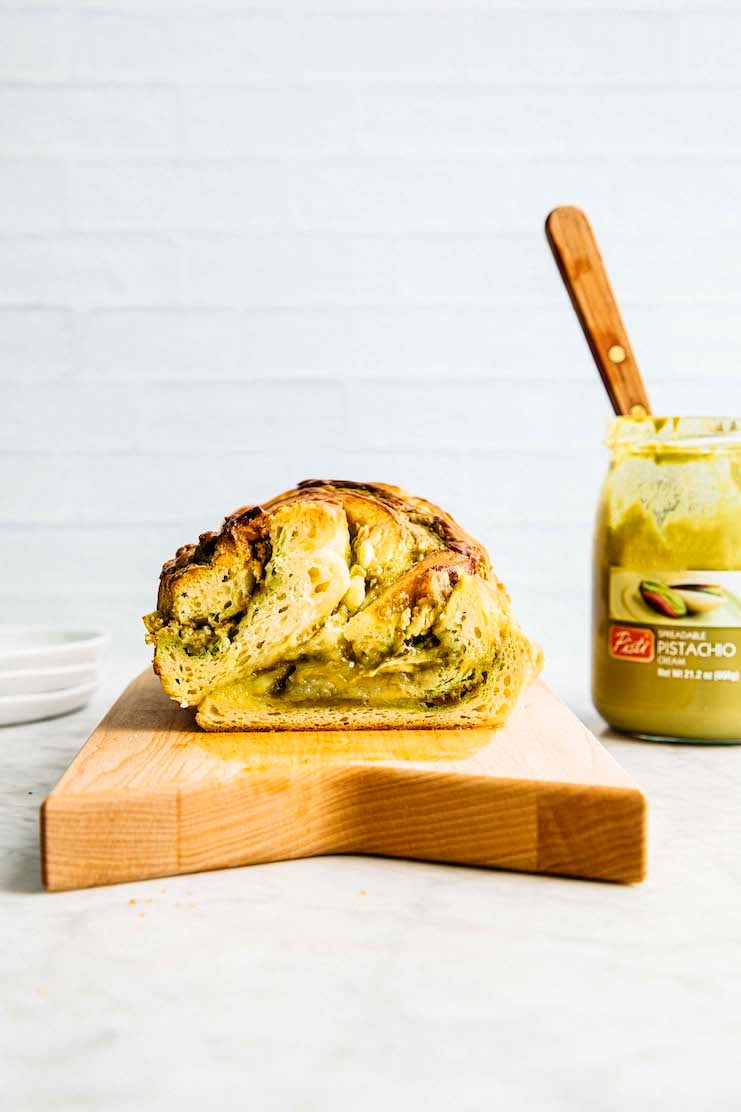
How To Make Babka
Below are the basic steps to make white chocolate pistachio babka from scratch. When making enriched doughs with butter, eggs, and milk, I like to proof the dough overnight. Why? Multiple reasons.
First, the longer rise overnight leads to a better flavored bread. Second, the butter, eggs, and milk can make the dough sticky and hard to work with at room temperature. Chilling the dough overnight ensures that it’s a dream to work with. Learn more below!
Day 1: Make the Babka Dough
- Prep the ingredients for the babka dough. (Prep Time: 10 minutes)
When working with doughs leavened with yeast, it’s especially important to pay attention to the ingredients. Specifically, make sure the ingredients are listed at the temperature specified by the recipe! Yeast can be a finnicky thing. If the ingredients it’s mixed with are too hot, it could kill the yeast. If the ingredients are too cold, it might not activate the yeast. So take the extra few minutes to ensure that everything is at the right temperature! - Make the babka dough. (Work Time: 15 minutes)
Once you’ve prepped the ingredients, it’s time to make the babka dough. Luckily, it comes together fairly quickly. Simply mix the dry ingredients like flour, sugar, yeast, and salt, then add the wet ones like milk, eggs, melted butter, and vanilla. Knead on medium-low for 10 minutes. That’s it! - Proof the dough. (Rise Time: 1 hour at room temperature, then overnight)
I mentioned this earlier, but I like proofing enriched doughs with milk, eggs, and butter overnight in the fridge. Doing so gives the dough a better flavor and makes it easier to work with the next day!
Day 2: Assemble and Bake The Babkas
First, prep the dough, baking pans, and ingredients for the filling.
- Prep the dough and pans. (Prep Time: 5 minutes)
Once you’re ready to assemble and bake the babkas, remove the bowl of dough from the fridge. Set it on the counter to warm it to room temperature for a few minutes while you prep the loaf pans for the babka. Doing so will make the dough easier to work with! - Prep the ingredients for the white chocolate pistachio filling. (Prep Time: 5 minutes)
Luckily, prep for the white chocolate pistachio filling is a breeze. Simply measure out the amount of pistachio cream and white chocolate chips needed for the recipe. That’s it!
Next, assemble the babkas.
- Roll out the babka dough. (Work Time: 10 to 15 minutes)
Once you’ve got your pans and ingredients for the filling organized, it’s time to assemble the babkas. Roll out the dough into a large rectangle about 10 inches wide and 24 inches long. The resulting slab will be around ¼-inch thick.
I’m not going to lie—rolling out the doigh is probably the most time-consuming part of the recipe. The dough will initially be stiff and hard to work with from being chilled. Don’t be afraid to give it a few whacks with your rolling pin to soften it up! It will become easier to roll out the more you work with it. - Fill and roll the babka dough. (Work Time: 5 minutes)
Once you’ve got your slab of dough, use an offset spatula to spread pistachio cream all over the dough (like you would butter on toast). Make sure to go all the way up to the edges of the dough for best results. Then, sprinkle the pistachio cream with the white chocolate chips.
After you’ve used up all your pistachio cream and white chocolate chips, it’s time to roll it back up! Starting from one of the long ends, roll the dough into an even log, like you would a burrito or when making cinnamon rolls. - Slice the babka dough. (Work Time: <5 minutes)
At this point, you should have what looks like an extra long burrito made out of dough and stuffed with pistachio cream and white chocolate. Now, this is where it gets wild: Use a serrated knife to cut the log in half lengthwise. Doing so will result in two strands of dough with the filling exposed.
Next, slice these 2 strands in half crosswise so that you have 4 shorter pieces of dough with the filling exposed. If you need a quick refresher on what it means to slice things crosswise versus lengthwise, I highly recommend this Buzzfeed article. And definitely check out the video tutorial below where I show you how to slice and braid the babka! - Braid the babka dough. (Work Time: <5 minutes)
Now, take the 2 of the 4 pieces and twist them together to form a simple braid. If you’re confused on how to do this, keep scrolling for the video tutorial. Repeat with the remaining 2 pieces. Congratulations! You just assembled your babkas.
Then, proof and bake the babkas.
- Proof the babkas. (Rise Time: 2 to 3 hours)
After you’ve assembled the babkas, transfer them to the prepared loaf pans. Tightly cover with plastic wrap and proof until very soft and jiggly to the touch, another 2 to 3 hours. If that sounds like a long time, check out the Baker’s Tips below on how to speed up this process! - Bake the babkas. (Bake Time: 40 to 45 minutes)
The babkas need 40 to 45 minutes in the oven. It can be a little hard to tell if they’re done; their tops tend to brown quickly and get more toasted than their gooey centers. I recommend using an instant read thermometer if you have one. The center of each loaf should read 190°F.
Finally, make the babka syrup and soak the babkas.
- Make the syrup. (Work Time: 5 minutes)
You need some time management skills for this recipe. About 10 minutes before the babkas are done baking, make the simple syrup. Combine the sugar and water for the syrup in a small sauce pan and bring to a boil, whisking to dissolve the sugar. Set the syrup on a wire rack to cool slightly as the babkas finish baking. - Soak the babkas. (Work Time: 10 minutes)
Once the babkas are out of the oven, immediately start soaking them with the syrup. Why? They tend to absorb more liquid while they’re still fresh and warm. For best results, don’t pour the syrup over the babkas—it will be too much all at once for the babkas to absorb. Instead, brush the syrup over the babkas with a pastry brush. At first, it will seem like there’s too much syrup—be patient! Allow the syrup to soak into the babkas a little before brushing more on.
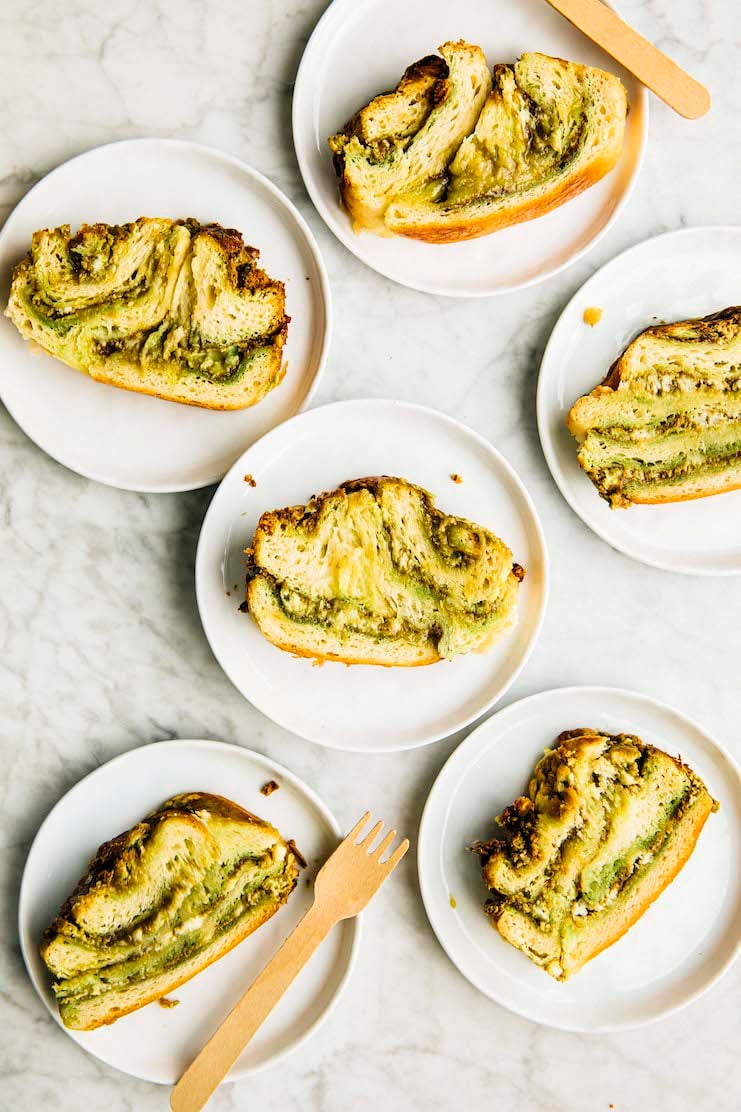
Recipe Troubleshooting and FAQ
FAQ: What Baking Equipment Do I Need To Make Babka?
Baking Equipment You Need To Make This White Chocolate Pistachio Babka Recipe
To make this recipe, I used the following equipment:
- a stand mixer with a dough hook
- a rubber spatula
- cooking spray
- plastic wrap
- two 9 x 5-inch loaf pans
- parchment paper
- a rolling pin
- a bench scraper
- an offset spatula
- a serrated knife
- a small saucepan
- a wire rack
- a pastry brush
I don’t own a stand mixer. Can I use a handheld electric mixer instead?
I don’t recommend it. Handheld electric mixers often don’t have the right kind of beater to knead dough. And even if your model comes with beaters specifically meant for kneading dough, the mixer itself usually isn’t powerful enough to knead the dough.
So instead, I recommend that you knead the dough by hand. However, you’ll need to knead it for an additional 5 to 10 minutes than what’s stated in the recipe below. It’ll be a good workout, I promise!
I don’t have two 9 x 5-inch loaf pans. But I do have two 8 x 4-inch loaf pans! Can I use that instead?
Yes, absolutely! I actually prefer baking babkas in smaller 8 x 4-inch loaf pans. I find that they come out taller.
What else can I use besides loaf pans?
Technically, you can bake the babkas on a parchment-lined sheet pan instead of loaf pans. However, the babkas tend to come out squatter and flatter (the loaf pans sides encourage them to grow upwards).
Other ideas? If you’re feeling especially creative, you can also twist the babka into a giant wreath like I did in this recipe for Cinnamon Raisin Wreath Bread. If you do, there’s no need to cut the dough in half to make two babkas—you can just make a giant wreath!
FAQ: Questions About The Recipe’s Techniques and Steps
Why does this babka recipe make two babkas? Actually, why do most babka recipes make two babkas?
Oh boy, do I have thoughts on this! Because I literally spent the last week trying to develop a single loaf babka recipe. Every trial was pretty much a disaster.
Why? You don’t need a ton of dough to make babka. That makes kneading it in a regular-sized mixer difficult (unless you happen to have a mini KitchenAid mixer). Because the mixer is unable to knead the dough properly, you end up with a dense and squat babka.
But a recipe for two babkas does away with these negatives completely. If you don’t love the idea of having two babkas, don’t worry! Assembled babkas freeze beautifully. Scroll down below for my instructions on how to freeze babka for serving later.
Can I halve the recipe to make just one babka?
Technically yes, but I don’t recommend it. Halving the recipe makes a small amount of dough that’s hard to knead in a mixer (unless you happen to have a mini KitchenAid mixer). If you insist on going this route, I recommend kneading the dough by hand.
That being said, halving the recipe also doesn’t make enough dough to get a good twist on your babka. You have to roll out the dough so thin—thinner than the ¼-inch thickness that I already call for—that it quickly becomes overworked and hard to work with.
I don’t want to wait overnight for my white chocolate pistachio babka. Can I make this recipe all in one day instead?
Yes! You can make this babka recipe all in one day.
To do so, follow the instructions to make the dough. However, instead of proofing it overnight in the refrigerator, proof it for 1 to 2 hours in a warm, draft-free spot.
Then, follow the instructions to fill and assemble the babkas. However, instead of proofing them for 2 to 3 hours, proof them for 1 to 2 hours instead.
I have the opposite problem. I can make the dough right away, but want to make the babkas a few days later. How long can I leave the dough in the fridge for?
After making the dough, you can keep it covered in the refrigerator for up to 3 days before filling, assembling, and baking the babkas.
FAQ: Troubleshooting Common Baking Errors and Problems
Help! My babkas tasted delicious, but don’t look as twisted and swirled as yours. What did I do wrong?
In the babka recipe below, I instruct you to roll out the dough into a fairly large rectangle that measures 10 inches wide and 24 inches long. If you slacked on rolling out your dough and rolled a smaller square than what I instructed, your babka won’t look as twisted and swirled as mine!
The most important thing is to roll it long as opposed to wide. The longer the dough, the more twists and swirls you end up with!
Help! My babkas tasted delicious, but came out short and squat. I was expecting them to have the height of a sandwich bread loaf. What did I do wrong?
First things first—babkas tend to be shorter and squatter than other breads like cinnamon raisin bread. They’re just built differently!
But if it seems unusually short and squat, it could be that its filling is uneven. If you didn’t spread it out evenly, the parts with more filling won’t rise as much as the parts with less filling.
And finally, if you want taller babkas in the future, I recommend baking the recipe in smaller 8 x 4-inch loaf pans. The smaller pan size will encourage the babkas to bake upwards as opposed to outwards!
FAQ: Questions About Serving And Storing Babka
How do you serve babka?
Babka is traditionally served warm, about 1 hour or so after baking. However, you can also serve it at room temperature.
For serving leftovers warm, you can reheat slices of babka in the microwave and/or toaster oven.
How To Store Babka
Serve warm, or at room temperature. The babkas will keep at room temperature, covered loosely in plastic wrap, for up to 3 days.
Can you freeze babka?
Yes! You can freeze this white chocolate pistachio babka recipe in two ways:
- Freeze the assembled, unbaked babkas before baking.
To freeze the shaped dough, tightly wrap it in two layers of plastic wrap, then a layer of aluminum foil. Freeze for up to 3 months.
To bake these babkas, unwrap them and let sit out at room temperature. Place them in parchment-lined and greased loaf pans and proof until the babkas have doubled in size. It will take several hours to do so since the babkas need to defrost, then rise—expect a Rise Time of about 5 to 6 hours, or maybe even overnight.
Once the babkas have risen accordingly, follow the recipe instructions to bake and soak the babkas in simple syrup. - Freeze the baked babkas for serving later.
If freezing the extra loaf of babka, cool completely to room temperature after soaking with simple syrup. Then, remove the babka from its loaf pan. Tightly wrap it in two layers of plastic wrap, then a layer of aluminum foil. Freeze for up to 3 months.
To serve, transfer the babka to thaw in the refrigerator overnight. Remove the plastic wrap and rewrap in the aluminum foil. Bake at 325°F for 8 to 10 minutes, or until warm. Then, unwrap the babka and bake uncovered for another 5 minutes. Serve immediately.
Best Babka Recipe Tips
Best Ingredient Tips
- Just another friendly reminder to make sure to pay attention to the ingredients and the temperatures they’re listed at in the recipe. Yeast is a living thing and you can easily kill it by mixing it in water that’s too hot. You want the temperature to be similar to that of a warm bath and no more.
- Also, make sure to use eggs that are at room temperature rather than straight from the fridge. Eggs straight from the fridge will be too cold and lower the temperature of the overall mixture, risking dropping it to a point where the yeast won’t activate properly.
- The dough recipe also instructs you to use butter that’s melted and cooled slightly. What does that mean? Similar to the water for the recipe, its temperature should feel like a warm bath. When I’m prepping ingredients for this recipe (and others that uses melted and slighted cooled butter), I like to melt the butter first (either over a gentle heat on the stovetop, or short bursts in the microwave to ensure it doesn’t get too hot). Once it’s melted, I prep the rest of the ingredients. That gives it enough time to cool slightly—by the time I’m done prepping the ingredients and ready to start the recipe, it should be at the right temperature!
Best Proofing Tip
- Dough rises fastest and best on warm, humid days. Although you can get the same effect on cold, dry days, it can take two to three times as long to proof dough. This is why professional bakeries have dedicated drawers to proof dough. The proofing drawer mimics the environmental conditions of a warm, humid day. And guess what? You can do that at home too, with the oven you already have.
First, if your oven has a pilot light, turn it on—doing so increases tehe temperature inside the oven by about five degrees. Next, bring 2 to 4 cups of water to a boil and pour it into a heatproof glass or ceramic bowl. Place the bowl of water in the oven, then place the dough you’re trying to proof next to it. The warmth from the light and moisture from the steaming, hot water will create a warm, humid environment in the oven to proof the dough faster.
Best Baking Tips
- Check the babkas 25 minutes into their Bake Time. If they’re browning too quickly, loosely cover each babka with a tent of aluminum foil.
- It can be hard to tell when the babkas are done baking. The skewer test isn’t as reliable since you might accidentally hit a patch of molten white chocolate chips. So if you have one, I suggest using an instant read thermometer to check for doneness! The center of each babka should read 190°F.
Video Tutorial Showing How To Assemble Babka
Use the video player below to watch my Instagram Story tutorial on how to assemble and braid this babka recipe! Clicking the right side of the frame allow you to skip forward through the different recipe steps. Conversely, clicking the left side of the frame allows you tos rewind.
More Babka Recipes on Hummingbird High
Get the Recipe: White Chocolate Pistachio Babka Recipe
Ingredients
For the Babka Dough
- 2 cups (9 ounces or 255 grams) all-purpose flour
- 2 cups plus 2 Tablespoons (8.5 ounces or 241 grams) cake flour
- ⅓ cup (2.35 ounces or 67 grams) granulated sugar
- 2 ¼ teaspoons instant yeast
- ½ teaspoon kosher salt
- ½ cup (4 ounces or 113 grams) whole milk, warmed to between 120°F to 130°F
- 2 large eggs, at room temperature
- ½ cup (1 stick or 4 ounces or 113 grams) unsalted butter, melted and cooled slightly
- ½ teaspoon pure vanilla extract
For the White Chocolate and Pistachio Filling
- 1 cup (9.5 ounces or 269 grams) pistachio cream
- 1 cup (6 ounces or 170 grams) mini white chocolate chips
For the Syrup
- ¾ cup (5.25 ounces or 149 grams) granulated sugar
- ½ cup (4 ounces or 113 grams) water
Instructions
Day 1: Make the Dough
- Mix the dry ingredients. In the bowl of a stand mixer fitted with the dough hook, combine the flours, sugar, yeast, and salt. Knead on low to combine, about 30 seconds. Press a tall glass into the center of the dry ingredients to make a well.
- Add the wet ingredients. Pour the milk, eggs, butter, and vanilla into the dry ingredients and mix with a rubber spatula until a rough, shaggy dough forms.
- Knead the dough. Use the mixer to knead on medium-low for 10 minutes, or until smooth and elastic, using a rubber spatula to scrape down the bottom and sides of the bowl as necessary.
- Proof the dough. Tip the dough out onto a lightly floured counter. Dust your hands with flour and knead the dough once or twice into a rough ball. Scrape down the bottom and sides of the bowl to remove any excess dough.Spray the bowl with cooking spray and place the dough back in the bowl. Cover with plastic wrap and let rise for 1 hour at room temprature before refrigerating overnight.
Day 2: Assemble And Bake The Babka
- Prep the dough and pans. Uncover the dough and discard the plastic wrap. Tip it onto a lightly floured counter. Spray two 9 x 5-inch loaf pans with cooking spray and line with parchment paper, leaving a 2-inch overhang on the long sides. Spray the parchment, too.
- Roll out the dough. Use a rolling pin to roll the dough into a large rectangle about 10 inches wide and 24 inches long. Press a bench scraper against the sides of the dough to create straight edges.
- Fill and roll the dough. Use an offset spatula to spread the pistachio cream evenly across the dough. Sprinkle the white chocolate chips evenly on top.Starting from one of the long ends, roll the dough into an even log, like you would a burrito or when making cinnamon rolls.
- Slice the dough. Use a serrated knife to cut the log lengthwise into 2 strands, each about 12 inches long.Use the knife to slice the 2 strands in half crosswise so that you have 4 pieces with the filling exposed.
- Braid the babkas. Position the 4 pieces so that the exposed layers are facing upwards and are parallel next to each other. Take 2 of the pieces and gently press together the end of each half. Then, lift the right half over the left half. Repeat this process, but this time, lift the left half over the right to create a simple, two-pronged plait. Repeat this process until there is no longer any dough left to braid — I think I was only able to cross the dough around 3 times or so. Squeeze together the ends. Congratulations! You just braided one of the babkas.Repeat with the remaining 2 pieces to create the second babka.
- Proof the babkas. Place the braids in the prepared pans and cover the top of the pans with plastic wrap. Set the loaf pans aside in a warm, draft-free spot until the dough is very soft and jiggly to the touch, 2 to 3 hours.
- Prep the oven. About 30 minutes before baking, position a rack in the center of the oven and preheat to 350°F.
- Bake the babkas. Bake the buns for 40 to 45 minutes, or until the edges are golden brown and an instant read thermometer inserted into the center of a babka reads 190°F.
- While the babkas bake, make the simple syrup. Combine the sugar and water for the simple syrup in a small saucepan. Bring to a boil over high-heat, whisking to dissolve the sugar. Set the syrup on a wire rack to cool slightly as the babkas finish baking.
- Soak the babkas. Once the babkas are done, place on a wire rack. Immediately use a pastry brush to brush the top of the babkas with the syrup, waiting until the babka(s) absorb the syrup before using more syrup—it will seem like there's too much syrup, but it will work out, I promise!
- Serve and store. Cool the soaked babkas in their pans on the wire rack for 1 hour. Serve warm, or at room temperature. The babkas will keep at room temperature, covered loosely in plastic wrap, for up to 3 days.
Notes
- Just another friendly reminder to make sure to pay attention to the ingredients and the temperatures they’re listed at in the recipe. Yeast is a living thing and you can easily kill it by mixing it in water that’s too hot. You want the temperature to be similar to that of a warm bath and no more.
- Also, make sure to use eggs that are at room temperature rather than straight from the fridge. Eggs straight from the fridge will be too cold and lower the temperature of the overall mixture, risking dropping it to a point where the yeast won’t activate properly.
- The dough recipe also instructs you to use butter that’s melted and cooled slightly. What does that mean? Similar to the water for the recipe, its temperature should feel like a warm bath. When I’m prepping ingredients for this recipe (and others that uses melted and slighted cooled butter), I like to melt the butter first (either over a gentle heat on the stovetop, or short bursts in the microwave to ensure it doesn’t get too hot). Once it’s melted, I prep the rest of the ingredients. That gives it enough time to cool slightly—by the time I’m done prepping the ingredients and ready to start the recipe, it should be at the right temperature!
- Dough rises fastest and best on warm, humid days. Although you can get the same effect on cold, dry days, it can take two to three times as long to proof dough. This is why professional bakeries have dedicated drawers to proof dough. The proofing drawer mimics the environmental conditions of a warm, humid day. And guess what? You can do that at home too, with the oven you already have. First, if your oven has a pilot light, turn it on—doing so increases tehe temperature inside the oven by about five degrees. Next, bring 2 to 4 cups of water to a boil and pour it into a heatproof glass or ceramic bowl. Place the bowl of water in the oven, then place the dough you’re trying to proof next to it. The warmth from the light and moisture from the steaming, hot water will create a warm, humid environment in the oven to proof the dough faster.
- Check the babkas 25 minutes into their Bake Time. If they’re browning too quickly, loosely cover each babka with a tent of aluminum foil.
- It can be hard to tell when the babkas are done baking. The skewer test isn’t as reliable since you might accidentally hit a patch of molten white chocolate chips. So if you have one, I suggest using an instant read thermometer to check for doneness! The center of each babka should read 190°F.
Did you make this recipe?
Please leave a comment and rating for the recipe using the form below!
Your ratings make it easier to find the recipe online, and I’m always looking for ways to improve Hummingbird High.

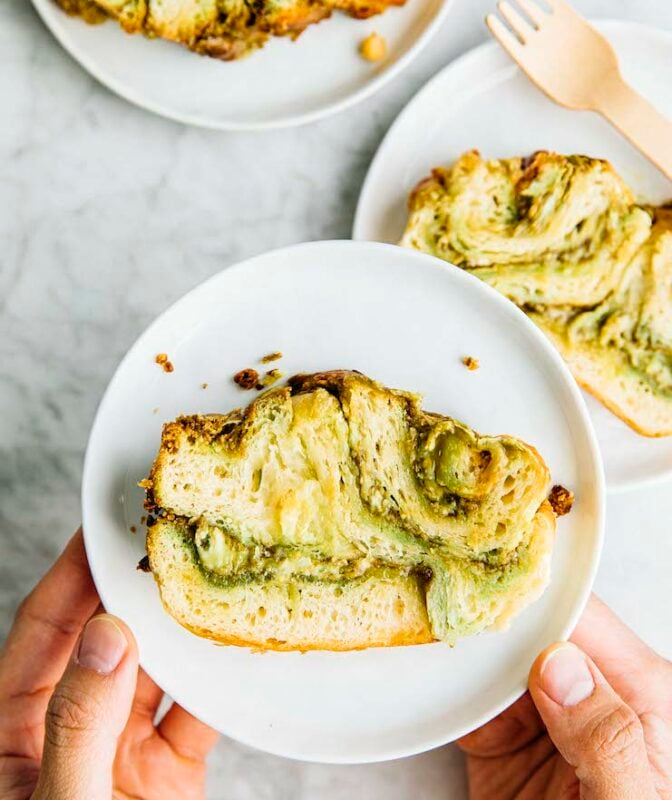
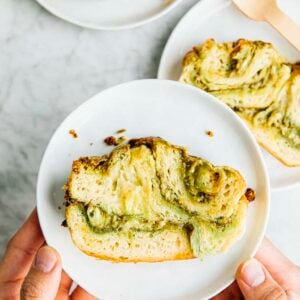
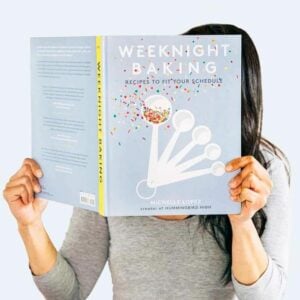

So good!! Very decadent- but so worth it.